Physical Address
304 North Cardinal St.
Dorchester Center, MA 02124
Physical Address
304 North Cardinal St.
Dorchester Center, MA 02124
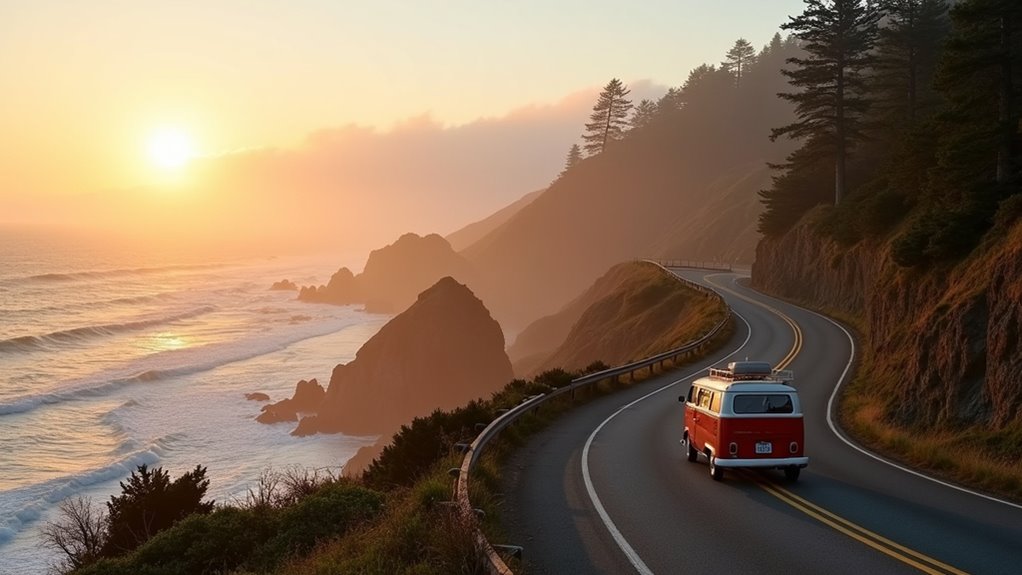
Opt for a scenic escape from the Bay Area to Oregon, where two distinct routes promise unforgettable adventures and hidden gems.
If you’ve been feeling the need to temporarily relocate yourself from the Bay Area’s bustling tech scene, a road trip to Oregon might be your perfect escape. You’ll find two main routes north: the swift but inland I-5, or the breathtaking coastal US-101. Your choice between these paths will shape your entire journey, from the time you’ll spend on the road to the unforgettable stops you’ll make along the way. Let’s explore how to make this adventure both memorable and budget-friendly.

When planning your Bay Area to Oregon road trip, you’ll need to choose between two main routes: US-101 and I-5. Your choice depends largely on your priorities and schedule.
I-5 is your fastest option, offering a direct inland path with consistent highway conditions and fewer stops. You’ll encounter less traffic than US-101, though speed enforcement is stricter. If you’re on a tight schedule, this route’s efficiency makes it your best bet.
For a no-nonsense drive north, I-5 delivers with steady speeds and minimal interruptions, though watch those speed traps.
US-101 takes longer but rewards you with stunning ocean views, charming coastal towns, and access to national parks. From the Bay Area northward, the iconic Pacific Coast Highway offers breathtaking views of cliffs and crashing ocean waves. You’ll face more traffic lights and local congestion, particularly in urban areas.
The route’s coastal location means possible weather-related delays in winter. Choose this path if you’ve got time to explore and want to incorporate scenic stops into your journey.
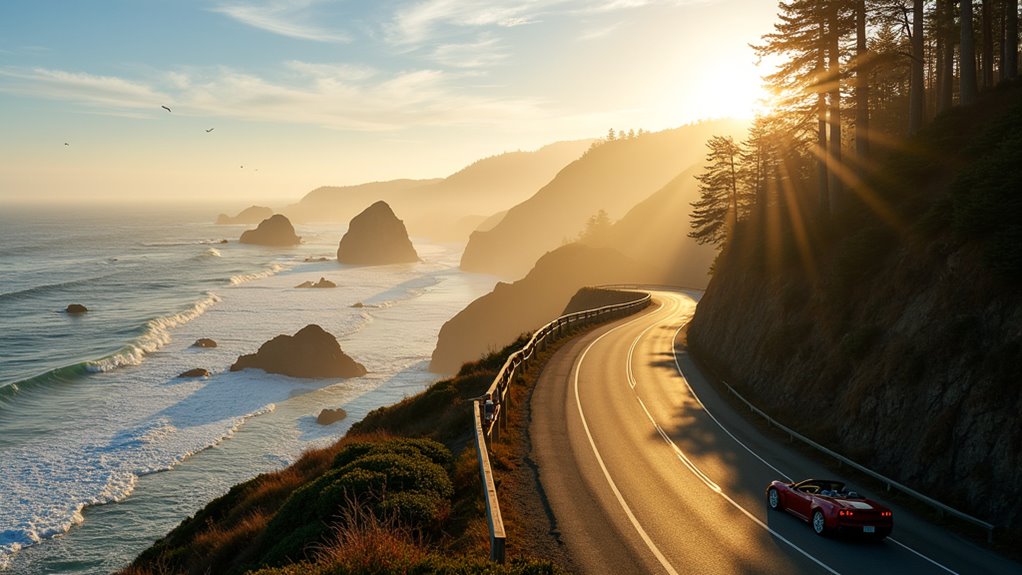
Plan for 8-12 days to fully experience the coastal adventure, with flexibility built into your timeline for unexpected discoveries along the way.
If you’re traveling in summer, you’ll want to book accommodations ahead, especially if you’re planning to stay at popular campgrounds or hotels. Traveling with toddlers requires planning extra rest stops along your route to keep little ones comfortable and content.
Consider renting a campervan, which offers both transportation and lodging in one package. This option lets you adjust your schedule more freely while saving on hotel costs.
Pack smart with layers for variable weather, and keep your daily driving time reasonable to allow for spontaneous stops.
Don’t forget to check local events and festivals that might be happening during your travel dates – they’re worth scheduling around.
For your first day’s journey, plan about five hours of driving from San Francisco to reach the majestic Avenue of the Giants.
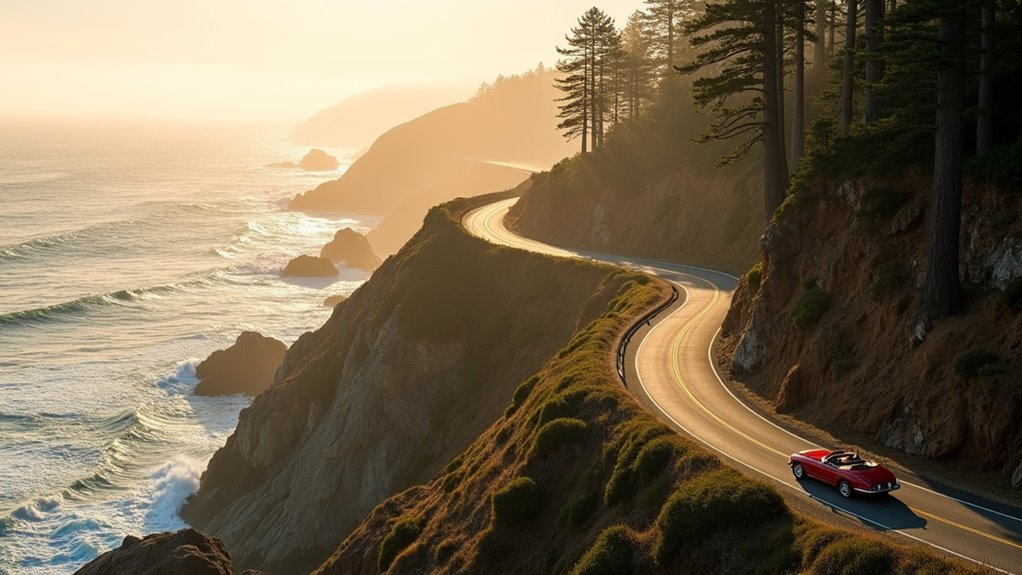
Your Pacific Coast journey offers an impressive collection of must-see landmarks and charming towns that showcase the best of California and Oregon.
Start at Point Reyes National Seashore to spot elephant seals and visit the historic lighthouse. This scenic drive allows you to enjoy narrow two-lane roads that hug the coastline for spectacular views. Head north to Big Sur’s dramatic coastline and iconic Bixby Creek Bridge.
Don’t miss the towering giants at Redwood National Park, where you can hike through ancient forests.
In Oregon, stop at Bandon and Florence to experience the rugged coastline and dune adventures. Newport’s harbor and aquarium are worth exploring, while Depoe Bay offers excellent whale watching opportunities.
Make time for Cannon Beach’s famous Haystack Rock and tide pools.
End your journey in Astoria, where you can explore Victorian architecture and film history while enjoying fresh seafood along the Columbia River.

Among the many highlights of a Pacific Coast road trip, the ancient redwood forests stand as natural wonders that shouldn’t be missed.
You’ll find the best redwood experiences along U.S. Route 101, where several key parks offer distinct viewing opportunities.
Start at Humboldt Redwoods State Park‘s Avenue of the Giants, then head north to Prairie Creek Redwoods State Park, where you can spot elk and hike scenic trails.
Continue to Jedediah Smith Redwoods State Park for affordable camping and the stunning Stout Memorial Grove. The Boy Scout Tree Trail, stretching 5.5 miles round trip, offers an immersive old-growth forest experience.
For fewer crowds and better photos, visit during spring or fall, when fog creates magical conditions.
Save money by combining your park visits – one entrance fee covers both Redwood National Park and the three adjacent state parks.
The Newton B. Drury Parkway offers a free, scenic alternative to Highway 101.
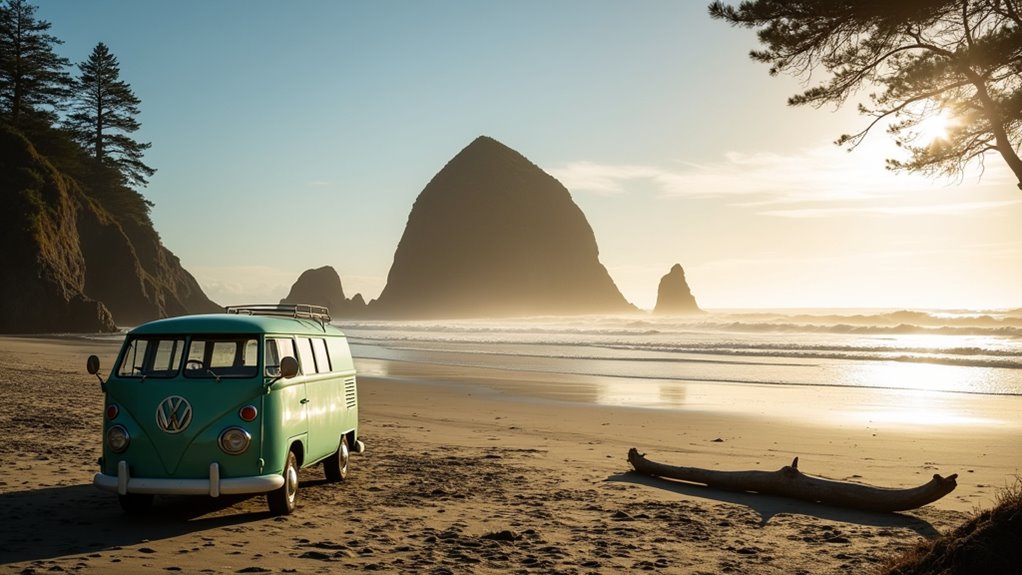
After crossing into Oregon, the stunning Pacific coastline reveals a treasure trove of must-see destinations that won’t break your budget.
Start at Fort Stevens State Park to explore the haunting Wreck of the Peter Iredale, then head to Seaside’s historic promenade for a budget-friendly stroll.
Don’t miss Cannon Beach’s iconic Haystack Rock, where you can spot puffins and explore tide pools for free. The beach offers perfect spots for a memorable evening with beach bonfires permitted.
For dramatic views without admission fees, visit Ecola State Park’s hiking trails and Cape Sebastian’s viewpoints.
When you need a break from the coast, swing by the Tillamook Creamery for free samples and self-guided tours.
Nature enthusiasts should prioritize Thor’s Well at Cape Perpetua and Devil’s Punchbowl at Otter Rock – both offering spectacular shows during high tide without entrance costs.
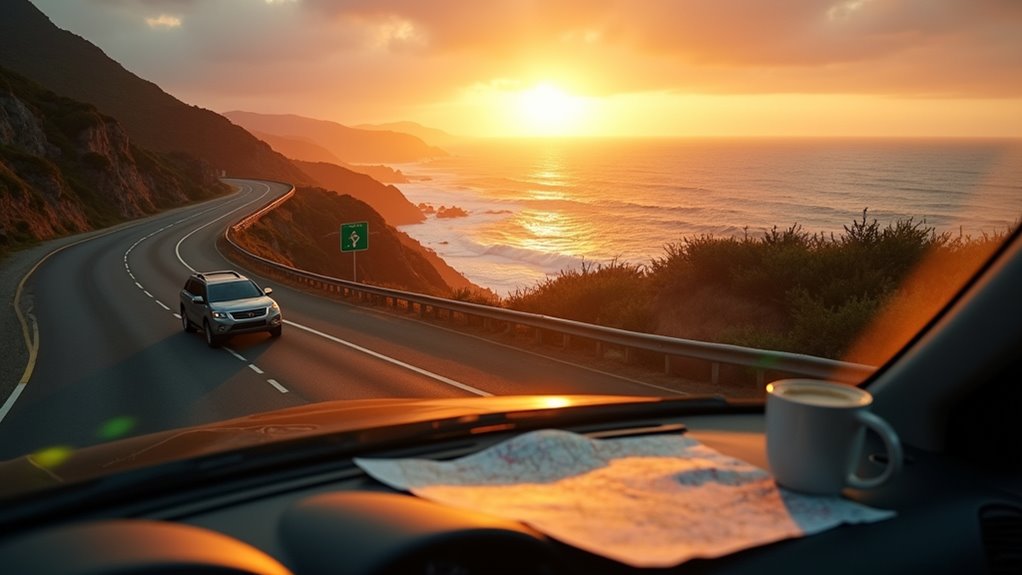
Breaking up the 560-640 mile journey from San Francisco to Oregon into manageable segments will help you maximize both safety and sightseeing opportunities.
Plan to cover 150-250 miles per day, which typically requires 3-4 hours of driving time and leaves plenty of room for exploration. Using a travel cost calculator can help you budget accurately for fuel expenses and overnight stays.
Start your drives early to take advantage of daylight hours and lighter traffic. You’ll want to schedule breaks every 1.5 to 2 hours to stay alert and comfortable.
Consider stopping overnight at strategic midway points like Redding, CA or Ashland, OR, which are about 4.5-6 hours from either end of your journey.
If you’re taking scenic coastal routes like Highway 1/101, factor in extra time for slower speeds and spontaneous photo stops.
Use real-time navigation apps to avoid traffic delays and adjust your route when needed.
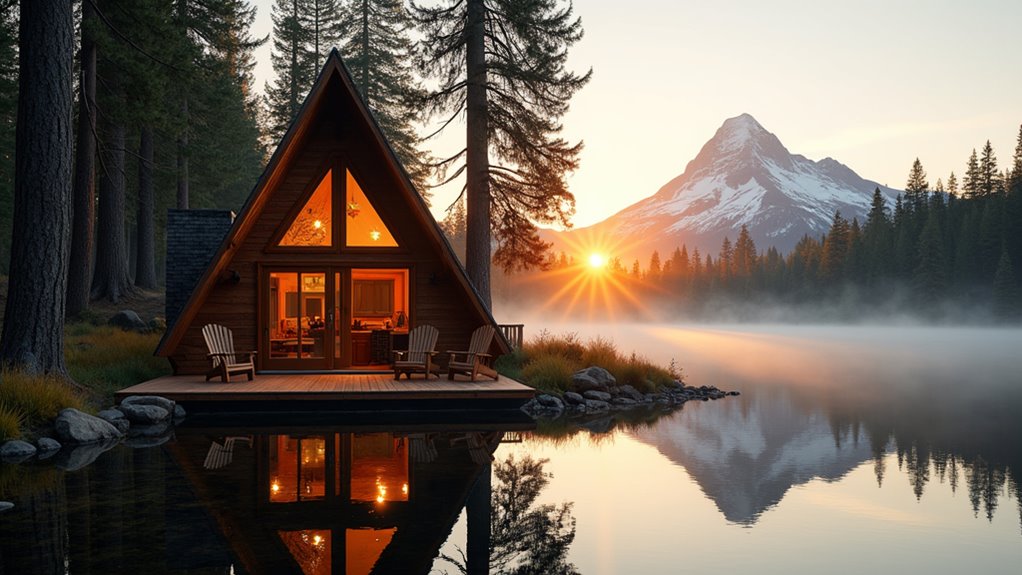
Now that you’ve mapped out your daily driving schedule, choosing the right places to rest and recharge becomes your next priority.
In Northern California, you’ll find excellent options along Avenue of the Giants, including Burlington Campground for budget travelers and the charming Benbow Historic Inn for those seeking more comfort. Scotia Lodge offers another welcoming alternative in this area. The Best Western Brookings offers stunning ocean-facing rooms for those continuing into Oregon.
As you continue north, Mendocino provides unique stays like the Little Elk Treehouse and Inns of Mendocino.
Along the Oregon coast, consider Wild Spring Guest Habitat in Port Orford or the Pacific Reef Hotel in Gold Beach. For mountain views, try Ashland Springs Hotel or Jacksonville Inn in Southern Oregon.
If you’re exploring the Columbia River Gorge, don’t miss Skamania Lodge or the historic Columbia Gorge Hotel.
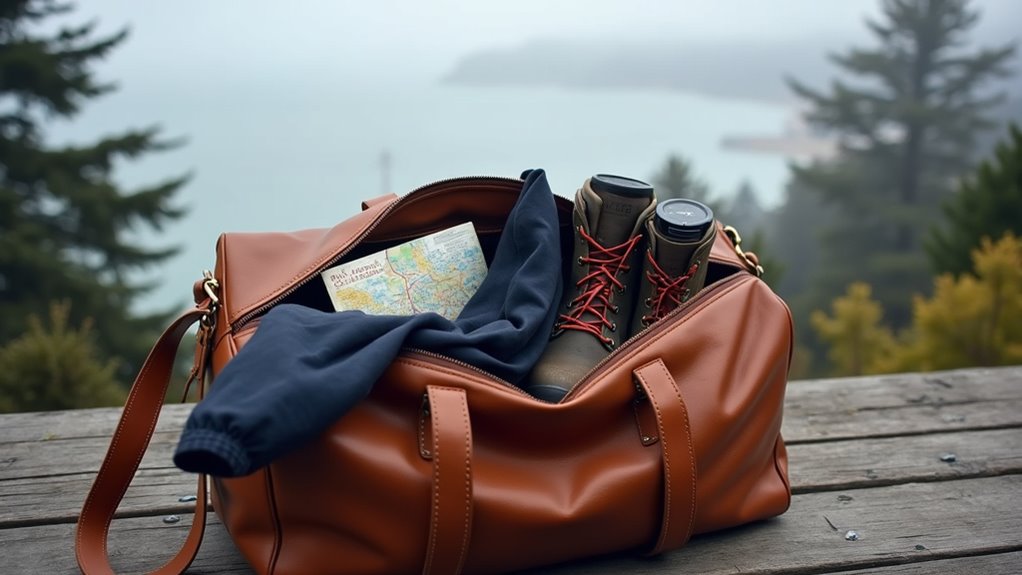
Packing strategically for the Pacific Northwest’s diverse environments can make or break your road trip experience.
Smart packing is essential in the Pacific Northwest, where one day’s mountain trek becomes tomorrow’s coastal adventure.
You’ll need versatile clothing that adapts to changing weather conditions, including waterproof hiking boots, wool socks, and a reliable rain jacket. Don’t forget long pants for trail protection and shorts for warmer coastal days. For efficient organization, use packing cubes to separate clean clothes from dirty laundry.
Your outdoor gear should include a multi-tool, dry bag, and backpack for day hikes. If you’re planning water activities, pack a life jacket, water shoes, and swimwear.
Safety essentials like bug spray, sunscreen, and a first aid kit are non-negotiable. Keep a water bottle handy for hydration, and store medications in an easily accessible spot.
Consider bringing travel games for evening entertainment at campsites, and don’t forget sunglasses for those stunning ocean views.
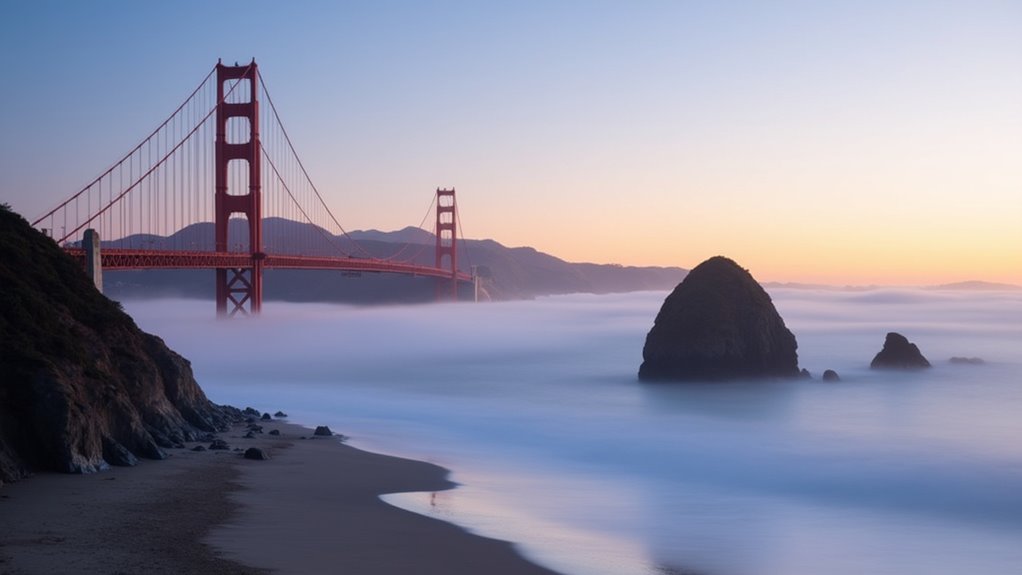
Stretching from Northern California’s towering redwoods to Oregon’s rugged coastline, this route offers photographers an incredible array of natural compositions.
Start at Avenue of the Giants, where you’ll find countless pullouts for capturing massive redwoods, especially in Founders Grove’s filtered morning light. Consider stopping at Armstrong Grove for a less crowded redwood photography experience.
Along the coast, don’t miss Trinidad State Beach‘s dramatic cliffs and Fern Canyon’s verdant walls. The Samuel H. Boardman Corridor provides dozens of vantage points for photographing sea stacks and natural bridges.
As you continue north, the Oregon Dunes create striking minimalist landscapes, while Heceta Head Lighthouse offers classic coastal scenes.
Cap your journey at Cannon Beach and Ecola State Park, where you can photograph iconic Haystack Rock and sweeping shoreline vistas. Time your coastal shots during golden hour for the best results.
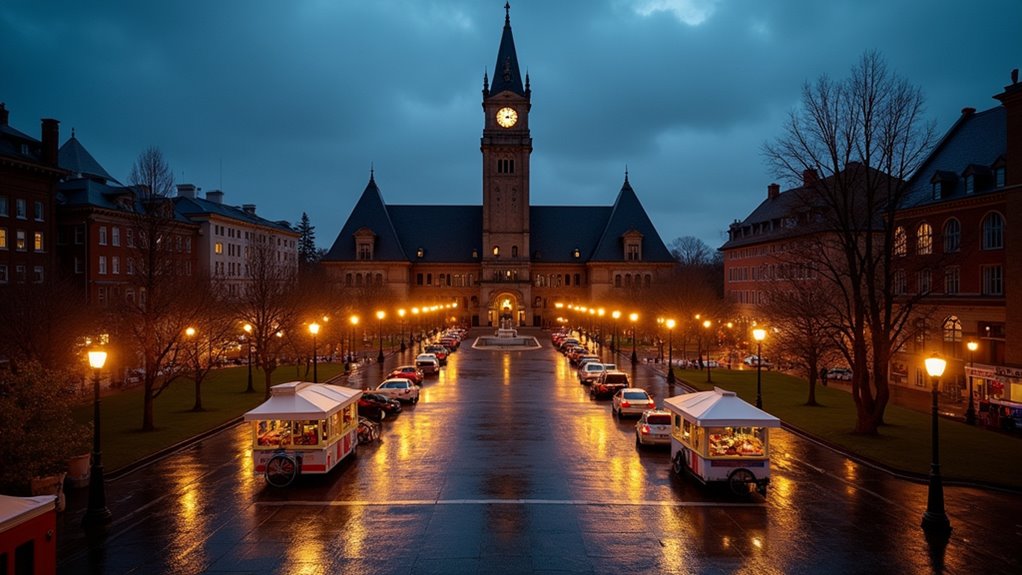
After winding your way through scenic coastal highways, Portland welcomes you with its dynamic blend of urban sophistication and laid-back charm.
Where rugged coastline meets city living, Portland strikes a perfect balance between metropolitan energy and easygoing Pacific Northwest spirit.
For the latest insights on visiting Portland, consider attending the State of the Industry event at the Portland Marriott Downtown Waterfront, where industry experts share current trends and data about the destination. You’ll find plenty of budget-friendly ways to explore the city, from tax-free shopping to strolling through its numerous parks and gardens. The city’s renowned culinary scene offers diverse options at various price points, while the visitor center can help you discover less crowded areas to explore.
Your San Francisco to Oregon road trip will give you the best bang for your buck when you balance planned stops with spontaneous adventures. You’ll find unforgettable experiences whether you’re camping under redwoods or splurging on a coastal B&B. Pack smart, drive safely, and keep your itinerary flexible. Remember, this Pacific Northwest journey isn’t just about the destination – it’s about making memories at every turn.